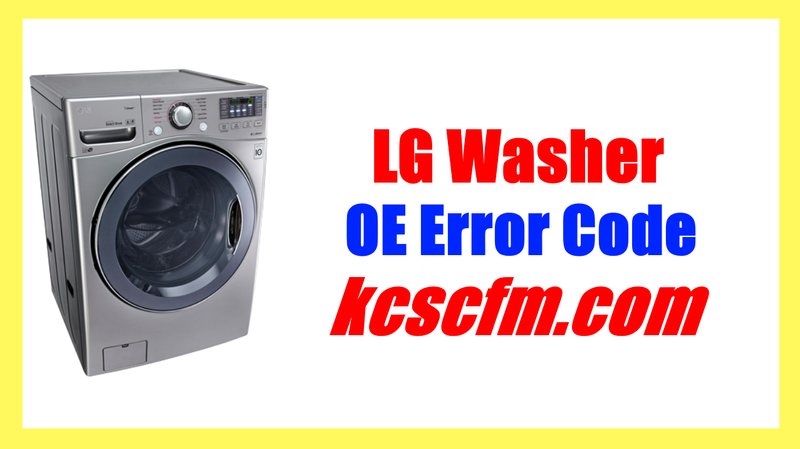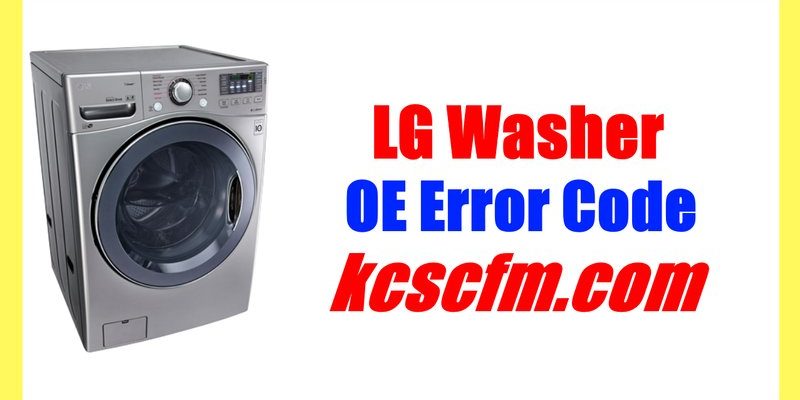
The OE error code on an LG washing machine is an indication that your machine is having difficulty with draining. Imagine trying to empty a bathtub but the drain is clogged – that’s similar to what’s happening inside your washer. Rather than letting the water out efficiently, it gets stuck, potentially leading to bigger issues down the line. This is why ignoring the OE error might not be the best idea. But don’t worry, you don’t need to be a tech wizard to handle this. Let’s break it down together.
What Does the OE Error Code Mean?
The OE error code is a friendly reminder from your washing machine that something’s amiss with its draining system. In simple terms, it’s like when your sink refuses to let water flow down the drain smoothly. This happens when there’s a kink in the hose, a blockage, or even a malfunctioning drain pump. When this error shows up, your machine is essentially saying, “Hey, I can’t get rid of this water. Can you lend a hand?”
Let’s delve a bit deeper into what might cause this issue. A common culprit could be the drain hose itself. If it’s kinked, the water simply can’t pass through. Think of trying to drink a milkshake through a bendy straw with a kink – it’s not going to happen easily! Alternatively, there might be a blockage somewhere in the drainage path. This could be due to lint, small clothing items, or other debris that’s managed to find its way into the system.
Sometimes, the issue could be with the drain pump. The pump is what helps push water out of the machine, so if it’s not working correctly, it’s like trying to push a door open that’s been jammed shut. It’s important to address these issues promptly because, over time, letting them linger could lead to more significant and costly problems.
Can You Fix It Yourself?
You might be wondering, “Okay, but can I fix this myself?” The answer is often yes, especially if you feel comfortable doing a bit of hands-on troubleshooting. First things first: ensure your machine is turned off and unplugged. Safety should always come first! Once that’s sorted, you can begin your investigation.
Start by checking the drain hose. Is it kinked or bent in any way? Straighten it out if necessary. Then, inspect for any visible blockages. Sometimes, simply moving the machine or adjusting the hose can solve the problem. If the hose seems clear, the next step is to check the pump filter. In most LG washers, this is located at the front, bottom right-hand side behind a small door. Unscrew the filter and clean out any debris. Be prepared for some water to spill out – it’s all part of the fun!
If these steps don’t work, the issue might lie with the drain pump itself, which can be trickier to fix without specialized tools or expertise. In such cases, it might be time to call in a professional. Remember, tinkering with parts you’re not familiar with can sometimes cause more harm than good. If you’re not confident, it’s always best to reach out to a technician.
The Consequences of Ignoring the OE Code
So, what happens if you decide to ignore this pesky OE error code? Well, continuing to use your washing machine without addressing the draining problem can lead to several issues. For starters, if the water doesn’t drain properly, your clothes won’t be cleaned effectively. It’s akin to taking a shower without rinsing off – not very effective, right? Moreover, the trapped water can become a breeding ground for mold and mildew, leading to unpleasant odors and even potential health concerns.
Beyond inconveniencing your laundry routine, ignoring the error can put additional strain on your washing machine’s components. Over time, this increased wear and tear can lead to more severe mechanical failures, resulting in expensive repair bills – that’s something everyone would rather avoid!
Furthermore, if the problem persists, it might impact other parts of your home’s plumbing system. Imagine a clogged artery in your heart that isn’t addressed; it leads to further complications. In the case of your washing machine, prolonged ignorance could cause water damage or leaking, which is a whole new headache.
Preventive Tips to Avoid Future OE Errors
The best way to avoid seeing the OE error code in the future is through regular maintenance and a few simple preventative measures. Think of it like taking vitamins to keep yourself healthy – small actions can significantly impact well-being.
Firstly, regularly check and clear the drain filter. This is where lint and small debris like to gather and make themselves at home. Keeping it clean can prevent blockages from forming in the first place. Secondly, ensure the drain hose is always positioned correctly without any kinks or bends. Make it a habit to glance at it each time you do laundry to ensure everything’s in perfect order.
Another handy tip is to avoid overloading your machine. Just like carrying too many bags of groceries, overloading puts extra strain on your machine, leading to wear and tear. Lastly, consider running an empty cycle with a washing machine cleaner every few months. This helps keep the inside of your machine fresh and reduces the chances of mold growth.
All these tips combined make for a healthy, happy washing machine – one that’s unlikely to confront you with an OE error code anytime soon. Keep these practices in mind, and you’ll be on your way to a seamless laundry experience.
